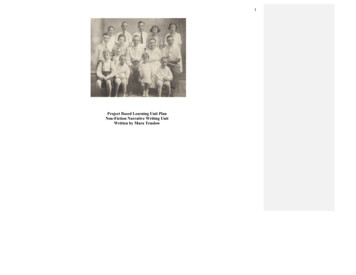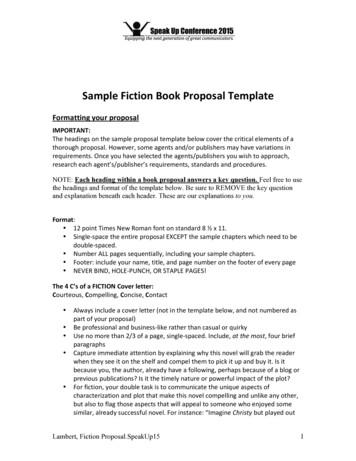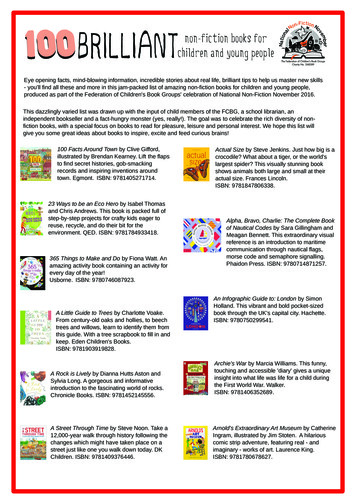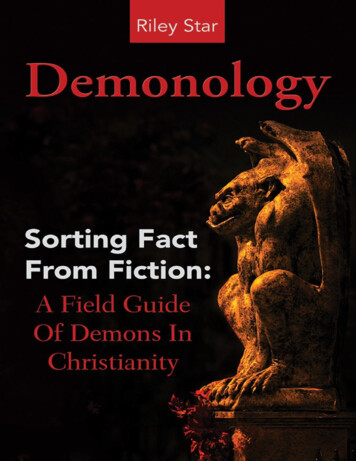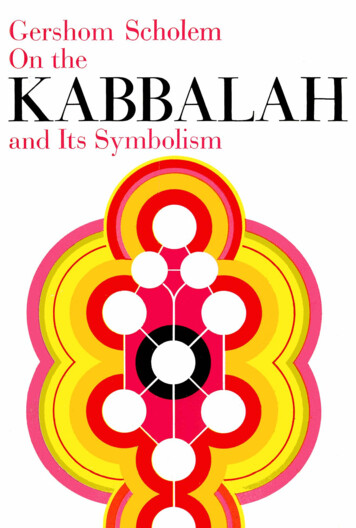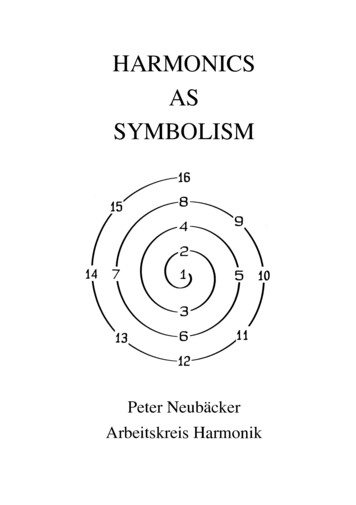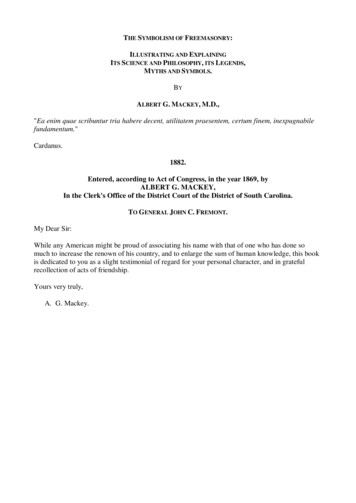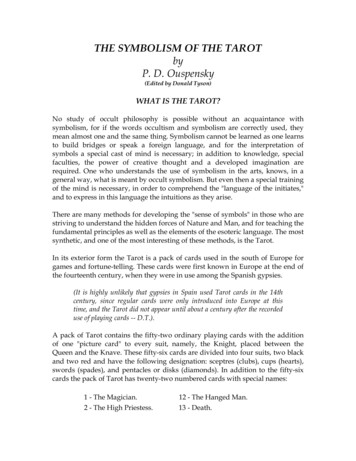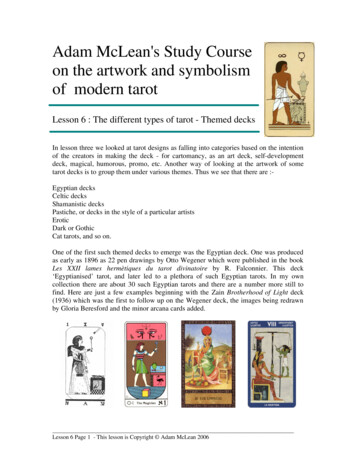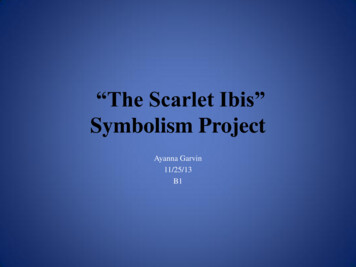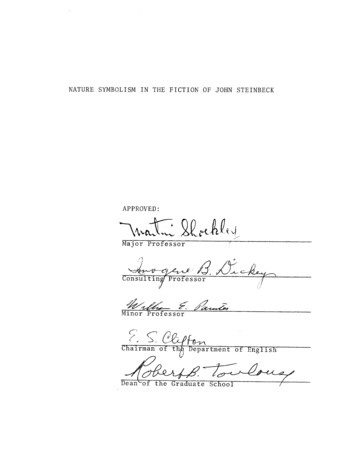
Transcription
NATURE SYMBOLISM IN THE FICTION OF JOHN STEINBECKAPPROVED:Major ProfessorConsulting' Professorf,J'ILMinor ProfessorChairman of thp, Department of English
r* ft1MU-Heitkamp, Jan, Nature Symbolism in the Fiction of JohnSteinbeck.Master of Arts (English), August, 1971, 155 pp.,bibliography, 52 titles.This thesis is concerned with nature as a source for muchof the symbolism and imagery in the novels and short storiesof John Steinbeck.The symbolism is examined from the perspec-tive of the philosophy governing Steinbeck's artistic use ofnature: that life is a unity and that man is one with nature.The analysis of the symbolism is organized into fourparts, each concerned with a particular motif for the naturesymbols.The first part discusses Steinbeck's use of the landas a symbol representing man's unity with nature.deals with animals as symbols.The secondMany of Steinbeck's charactersare endowed with animalistic traits.Furthermore, he frequentlyuses animals as symbols of human behavior.The third partconcerns the nature symbolism that embellishes themes of birth,death, and fertility.The final chapter concerns Steinbeck'suse of the sea as a nature symbol.Sources for the thesis are Steinbeck's major novels andcollected short stories.In most of these works, nature sym-bolism frequently plays a major artistic role and falls intoone or more of the four thematic patterns.Basically, thesymbols serve to interpret and comment upon the idea that alllife is sacred and that man is a part of the unity of nature.
NATURE SYMBOLISM IN THE FICTION OF JOHN STEINBECKTHESISPresented to the Graduate Council of theNorth Texas State University in PartialFulfillment of the RequirementsFor the Degree ofMASTER OF ARTSByJan Heitkamp, B. A,Denton, TexasAugust, 1971
PREFACEAny discussion of literary symbolism must be guided bythe limitations implied in the term "symbol."In simplestterms a literary symbol is "a trope which combines a literaland sensuous quality with an abstract or suggestive aspect."" In other words, it is an object which exists itself and at thesame time suggests something else, something abstract.Thusthe cross, an object perceived by the senses, is symbolic because it embodies all the philosophy, tradition, and feelingbehind Christianity.William York Tindall distinguishes symbol from sign bydefining sign as an exact reference to something definite andsymbol as an exact reference to something indefinite. If weaccept Tindall's distinction, a simile or a metaphor, whichexpresses a relationship between two objects, must be calleda sign.We encounter a problem with Tindall's distinction,however, when we consider the following simile from To a GodUnknown: "[The madrone trees] thrust up muscular limbs as redas flayed flesh and twisted like bodies on the rack.""*Thissimile is an analogy between two definite things, the limbs ofthe trees and tortured human flesh.Yet the image cannot be William F. Thrall and Addison Hibbard, A Handbook toLiterature (New York, 1936), p. 478. William York Tindall, The Literary Symbol (New York, 1955),p. 6. John Steinbeck, To a God Unknown (New York, 1933), p. 11.iii
called merely a sign because in context it suggests somethinggreater and more indefinite than a twisted body.Implicit in*the image is the hint of evil which pervades the entire novel.To draw a distinction between image and symbol is difficult, especially in Steinbeck's works, where so many of theimages carry meanings beyond themselves.In Of Mice and Men,for example, the constant comparison of Lennie to the small,furry creatures he loves to pet cannot be dismissed as onlyimagery or metaphor, for these animals suggest the characterand fate of Lennie.For a meaningful analysis of Steinbeck'snature symbolism, then, the reader must recognize that imageand metaphor may be symbolic; that is, they may imply morethan the one-to-one correspondence between sign and referent.Whenever nature imagery appears in Steinbeck's fiction tosuggest something larger, more abstract, than the literal,sensual aspect of the image itself, it will be viewed in thisstudy as symbolic.Perhaps the best working definition of asymbol, at least for the purposes of this discussion of naturesymbolism, is Steinbeck's own:A symbol is usually a kind of part of an equation-it is one part or facet chosen to illuminate aswell as to illustrate the whole. The symbol is neverthe whole.4In Steinbeck's fiction, then, when any object, image, or actserves to "illuminate as well as to illustrate the whole,"it may be considered symbolic.4John Steinbeck, Journal of a Novel (New York, 1969), p. 27,iv
TABLE OF LAND SYMBOLISM6ANIMAL SYMBOLISM63BIRTH AND DEATH SYMBOLISM118SEA SYMBOLISM137CONCLUSION151BIBLIOGRAPHY15 5
CHAPTER IINTRODUCTIONIn evaluating the significance of John Steinbeck as atwentieth-century American writer, one must certainly takeinto account the versatility of his literary art.A prolificnovelist, he experimented with a variety of themes and techniques.The thematic concerns of his fiction encompass a vastscope, from the carefree, idyllic life pictured in such novelsasTortilla Flat and Cannery Row, to the quasi-religious devo-tion to the land in T a God Unknown, to the ardent socialprotest of In Dubious Battle and The Grapes of Wrath.Stein-beck's artistic technique is as diverse as his subject matter.He can reproduce the vernacular of the itinerant workers andthe poetry of the Bible with equal facility.In form hisnovels vary from the loose, episodic structure of The Pasturesof Heaven to the tightly unified Of Mice and Men.Imagery andsymbolism embellish the narration and exposition in his stories,making it possible to interpret them on several levels.For all of Steinbeck's diversity of form and content,however, certain metaphorical and symbolic patterns recur frequently enough throughout his fiction to require close scrutiny.One such motif is nature, which plays a significant technicalrole in most of his novels.Much critical attention has beendevoted to the nature theme in the novels, but a comprehensiveexamination of exactly where and in what context Steinbeckuses nature as a symbol is a task which as yet has not concerned1
critics.The purpose of this thesis is to investigate therecurrence of nature symbolism in Steinbeck's fiction and toattempt to trace significant patterns in its use.Steinbeck is no stranger to the natural world from whichhe selects his symbols.He was born and reared in the SalinasValley, in central California, a fertile and picturesque areawhich runs parallel to the Pacific Coast for about one hundredtwenty miles.Bounded on the east by the Gabilan Mountainsand on the west by the Santa Lucia Mountains, the valley consists of Salinas, Steinbeck's birthplace; the Monterey Peninsula, the setting for Tortilla Flat, Cannery Row, and SweetThursday; and Pacific Grove, a middle-class, Methodist community which Steinbeck gently satirizes in several stories.love for this rural valley is evident in his fiction.HisIt servesas the setting for most of his works, and almost all the natural features of the valley appear symbolically throughout hisfiction.Most of Steinbeck's symbolic use of nature is governedby his belief in the unity of all life.In The Log from theSea of Cortez, the journal of a semi-scientific expeditionSteinbeck made with his biologist friend Ed Ricketts, he
expresses the core of the philosophy that underlies his use ofnature symbolism:If one observes in a relational sense, it seemsthat species are only commas in a sentence, thateach species is at once the point and the base ofa pyramid, that all life is relational to the pointwhere an Einsteinian relativity seems to emerge.And then not only the meaning but the feeling aboutthe species grows misty. One emerges into another,groups melt into ecological groups until the timewhen what we know as life meets and enters what wethink of as non-life. . . . And units nestle intothe whole and are inescapable from it.lTo Steinbeck all individual life is part of a great whole, andeach individual organism is both itself and the expression ofthis whole.Man is a part of this whole, and he intuitivelyrealizes his relationship to the rest of natural life.ForSteinbeck, there is a mysticism approaching a religious feeling in the recognition of the place of man in the unity of alllife:And it is a' strange thing that most of the feelingwe call religious, most of the mystical outcryingwhich is one of the most prized and used and desiredreactions of our species, is really the understandingand the attempt to say that man is related to thewhole thing, related inextricably to all reality,known and unknowable. This is a simple thing tosay, but the profound feeling of it made a Jesus,a St. Augustine, a St. Francis, a Roger Bacon, aCharles Darwin, and an Einstein. Each of them inhis own tempo and with his own voice discovered andreaffirmed the knowledge that all things are onething and that one thing is all things--plankton, ashimmering phosphorescence on the sea and the spinning planets and an expanding universe, all boundtogether by the elastic string of time (LSC, p. 217)."'"John Steinbeck, The Log from the Sea of Cortez (New York,1951), p. 216. Subsequent references to this volume will beindicated in the text as (LSC) with appropriate page number.
Steinbeck's position, then, is somewhere between the naturalistand the mystic, the scientist and the pri-est.Man's relation-ship with nature is in part instinctive, and in part, religious.To him, nature is at once a mother, a god, and anextension of himself.Because Steinbeck views "Being as a mystical allness,"it is appropriate that one of the main sources for the symbolismand imagery that interprets human activity should be nature.Nature symbolism in the novels appears in connection with fourmain motifs.The most predominant is the relationship betweenman and the land, a relationship which has at times a mystical,intuitive quality, as does man's relationship with all ofnature.Corresponding to man's kinship with the land is hisunity with animal life.Besides giving many of his humancharacters distinctly animalistic traits, Steinbeck usesanimals as symbols to comment upon human actions.He also usesnature symbolism in themes of birth and death, for both expressand affirm the cycle of nature.Finally, he occasionally usesthe sea as a symbol, for man is related to the sea in the sameway he is related to the land.In this paper the examination of Steinbeck's use of natureas symbol will be organized into four chapters, which willdiscuss in detail the four thematic uses of nature symbolism.Each chapter will be concerned with explaining the particular2Charles Child Walcutt, American Literary Naturalism, ADivided Stream (Minneapolis, 1956), p. 264.
symbols and determining their significance in the context ofthe novel in which they appear.An understanding of Steinbeck'suse of nature as a major symbol will facilitate a clearerperception of his observations about man.
CHAPTER IILAND SYMBOLISMRecognition of the unity of all life is the basis forSteinbeck's artistic use of nature.One of the major expres-sions of this unity is the kinship that man feels with theland.To Steinbeck, the land may be a source of man's strength,giving a pristine purity to those who are attuned to the rhythmof nature.This appreciation of the unity between man and theland is intuitively felt by many of his charactersand attimes assumes the characteristics of a religion, a mysticism.Another important manifestation of man's feeling of unity withthe land is the longing of many of Steinbeck's characters foran earthly paradise, a dream of a "safe place," where,unencumbered by society, they may enjoy the simple, primitive life.These variations on the theme of unity of the cosmosunderlie the land symbols in Steinbeck's fiction.Settingplays an integral part in the fiction, for the topographicalfeatures of the land, as well as the land itself, are sourcesfor much of Steinbeck's nature symbolism.This chapter willbe concerned with land symbols and their importance to thethemes of the novels.The discussion will reveal certainrecurring uses for land symbols and will demonstrate the importance of setting in Steinbeck's work. Woodburn 0. Ross, "John Steinbeck: Naturalism's Priest "College English, X (May, 1949), 434.'
Steinbeck's first novel, Cup of Gold, is important to thisdiscussion because it introduces themes which in his later*works are developed through the use of land symbols.Alreadyin this novel the theme of the unity of man and the landappears in rudimentary form.Robert, the father of the pirateHenry Morgan, is portrayed as a "primitive" whose feeling forthe land borders upon eccentricity.The symbol for thisfeeling is the rose:Robert was working the soil about the roots of arose bush with his strong brown hands. . . . Nowand again he stroked the gray trunk of the bushwith the touch of great love. It was as thoughhe smoothed the covers over one about to sleepand touched its arm to be reassured of its safety.The bloom of the rose reappears in the novel with implicationsof the mystical nature of the man-land relationship:'One day, when I was pulling the dead leaves frommy roses, it came upon me to make a symbol. Thisis no unusual thing. How often do men stand onhill tops with their arms outstretched, how oftenkneel in prayer and cross themselves. I pulled abloom and threw it into the air, and the petalsshowered down about me. It seemed that this actgathered up and told the whole story of my life ina gesture' (CG,pp. 145-146).Another prominent theme that is introduced in Cup of Goldis the need of man to dream.The dream idea that appears inthis novel is translated in subsequent novels to the desirefor an earthly paradise.2Here, however, the dream of HenryJohn Steinbeck, Cup of Gold.(New York, 1929), p. 18. Allsubsequent references to Cup of Gold will be indicated i
the sea as a symbol, for man is related to the sea in the same way he is related to the land. In this paper the examination of Steinbeck's use of nature as symbol will be organized into four chapters, which will discuss in detail the four thematic uses of nature symbolism. Each chapter will be concerned with explaining the particular 2

